Portals to inaccessible worlds
The symbiotic bond between the wandering saree salesman and his patroness
Earlier this month, I got a call from Amit B (name changed), the Bangladeshi vendor of handloom sarees who has been visiting our home for several years now. Amit belongs to a village in Bangladesh that is very close to the India border. For several years, he has been traveling back and forth between the two countries over land through the Benapole-Petrapole border crossing, trading in traditional handloom textiles, mostly sarees. On the Bangladesh side, he liaisons with weavers; in India, he warehouses his material in a border village, from where he sends batches via goods train to a partner based in Delhi. Twice a year, with Delhi as his base, he travels through north India’s cities - Gurgaon, Noida, Jaipur, Lucknow - showcasing his wares at the homes of regular customers and new homes referred to by them.
Not long ago, traveling salesmen were common fixtures in the cities of the Indian subcontinent, bringing in exotic wares from faraway lands. In north India, where upper class households were often gender segregated, they had privileged access to the women of the household, who bought clothes, baubles and trinkets from them. Not just nomadic salesmen, the local bangle seller would also bring his wares into homes, where women could try and select them at leisure. Even when women were not disallowed from going to the bazaar, allowing traders into the home allowed enterprising and socially ambitious women the chance to play host and invite neighbours and relatives over, while creating a niche mini-market for the seller. A win-win situation!
Things are radically different now and yet, some features carry over. Amit keeps in touch with his regular customers and offers them attractive discounts and gifts. They are, after all, invaluable as portals to a world of high-income individuals with a taste for traditional textiles who live behind the securitised apparatus of gated communities.
I met Amit over a decade ago when my mother-in-law and I were invited by family friends to peruse his wares. I remember enjoying the display but I bought something merely out of courtesy. This was Step 1 - being gently drawn in. The year after, when Amit came to our home, he recognised us as true handloom lovers and brought out his best wares. Smitten, we bought a few exclusive pieces. This was Step 2 - we graduated into the category of handloom addicts. On another visit, he asked me for references and I made a few calls. Step 3 - I was a patron, an advocate for him and his wares. This latest visit, a few weeks ago, my teenage daughter was also witness to the elaborate ritual of storytelling, showcasing, selecting and purchasing. This was Step 4 - we were family.
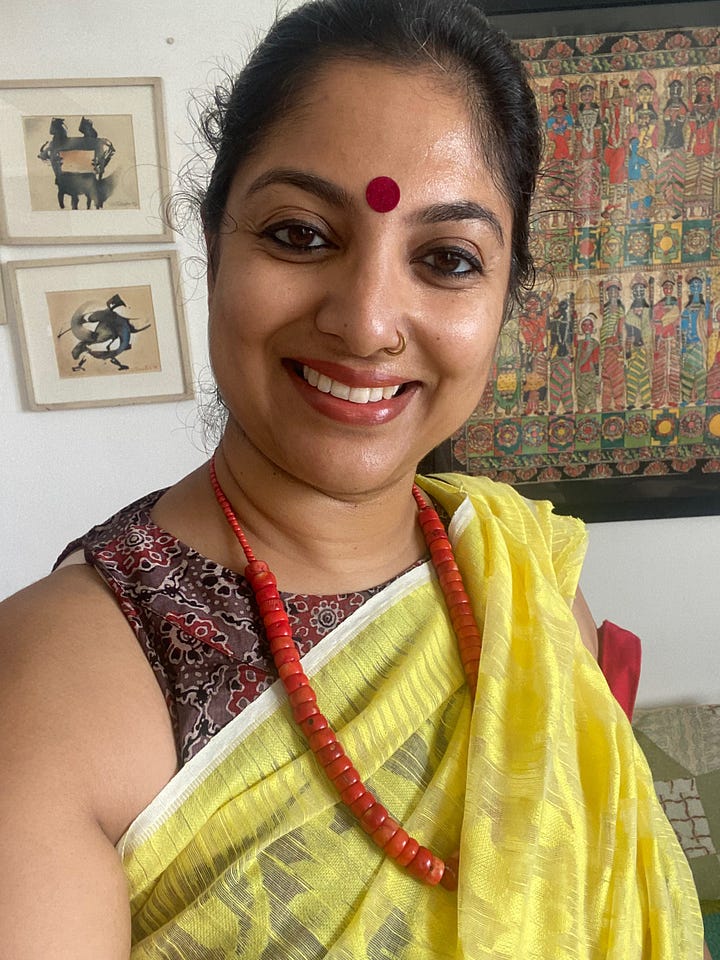
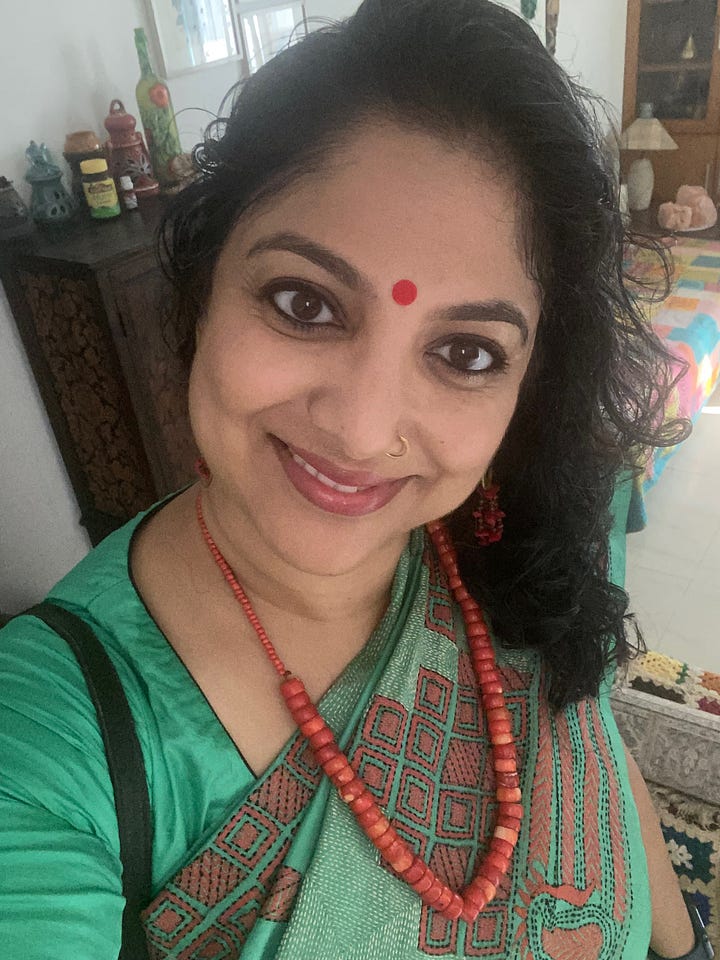
None of his happened without our complicity. A lifetime of visiting bazaars in Lucknow and Delhi has alerted us to all the tricks that talented salesmen use, but Amit’s knowledge and passion for his wares ran deep. He could talk extensively about how the kantha embroidery is done, by whom and in what kind of locations. He could describe the set up of the jamdani loom, innovations in the kind of yarn being used, the costs involved, and the dynamics within the households that carried forward these textile traditions. This time, we learnt about how policies in Bangladesh that block the import of cheap Chinese synthetic yarn are giving these handloom clusters a last chance at survival - and perhaps revival - despite the attrition in talent and slow cultivation of demand.
It’s pretty simple. The patronage of high-end urban consumers is vital for the survival craft clusters, which are located in impoverished rural parts of India and Bangladesh. Governments play their part though enacting policy. Their adoption by designer labels expands the market and offers much-needed branding and visibility. Amit name dropped like crazy, naming a slew of Bollywood stars, politicians, influencers who patronised designers selling exclusively handlooms and handcrafted fabrics like jamdanis, kanthas, gheenchas, and so on. No doubt they paid a pretty package for the labels and one can only hope that the craftspeople who actually made the pieces were adequately compensated.
In all this, the work that traders like Amit B do is invaluable too, not just because it allows handloom lovers like me, who are not quite in the league of the rich and famous, access to quality and authentic products. The deeply personal, interactive and educational nature of the sales process has an affective quality that binds me, albeit indirectly, to the communities that produce this wearable art. It also allows for rare interactions in an increasingly segregated world. The wonder in my teenager’s eye when she learns about the time and effort that goes into each unique saree is worth far more than the money I might spend on it. I believe that the positivity and confidence I feel when I drape these masterpieces draws on the artistry and meticulous labour of artisans, who are no longer anonymous thanks to Amit’s vivid stories.
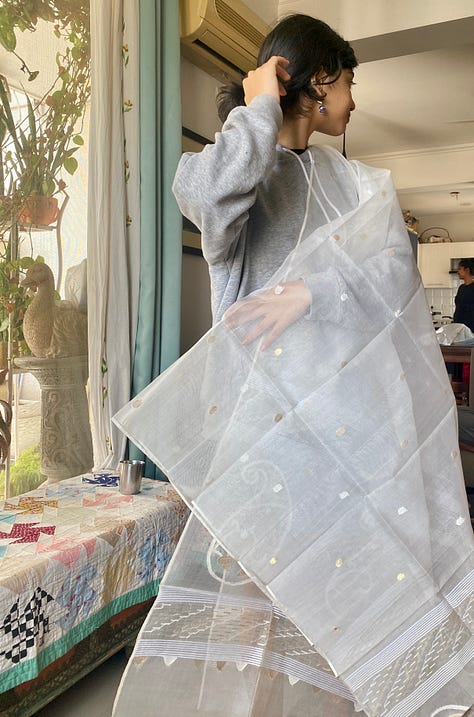
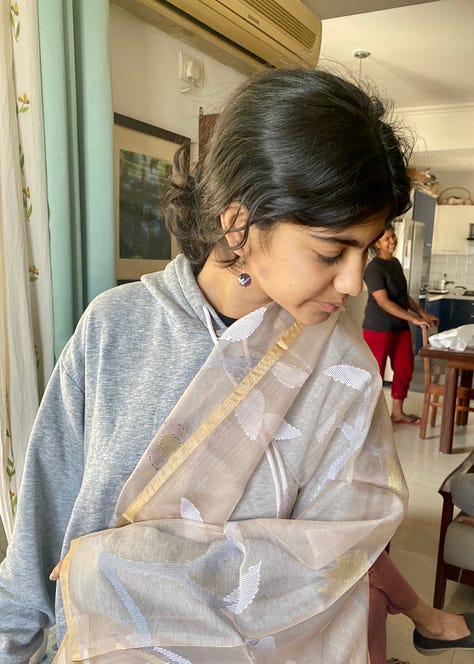
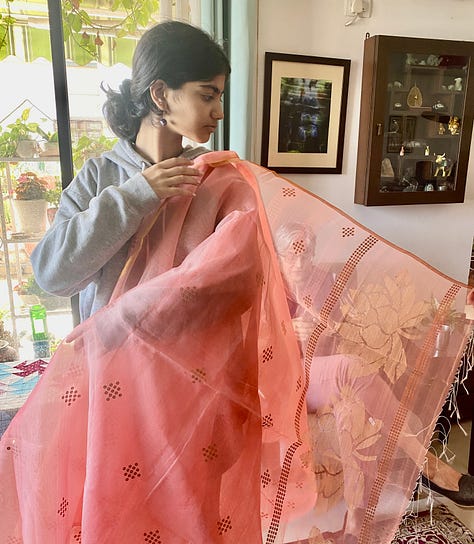
By acting as portals to unfamiliar worlds, Amit B and I are in a kind of symbiotic relationship. My patronage and referrals permit him to enter a world where the value of his exquisite wares is recognised, or at least given a fair chance. His passion and labour offer me direct access to the art I love alongside deeper insights into the social, political and cultural complexities that make its production still possible in a globalised world of fast fashion and rampant consumerism. This is a win-win too!
In and Around, Up and About
I’m experimenting with adding this new segment to my newsletter about interesting interactions, events, writings that touched me in the past week
Hamari Virasat, a traveling exhibition showcasing 75 textile tapestries inspired by the art of India’s Constitution made by women across the country, recently visited Delhi. Read a lovely report here by the talented Damini Jaiman. I enjoyed visiting the exhibition, especially because it paid tribute to the women who were part of the drafting group of this amazing and exemplary document. Here’s my mum, herself a ‘Midnight’s Child’, born in 1947 a few days before Independence, posing with the poster.
Thanks to my friend Kalpana from Safetipin, I had the chance to watch the film ‘No city for women’ set in Gurgaon, where I live. Directed by Rangan Chakravarty, edited by Arjun Gourisaria and based on research led by Nandini Gooptu, Oxford Department of International Development as part of the GendV Project, it captures how difficult it is for women to navigate life in capitalist urban India, especially when urbanisation happens through a brutal takeover of rural lands and lifestyles. You can hear some really authentic voices from women in Gurgaon on their project website.
Holi, the festival of colours, brings in a particularly festive mood. Despite the bizarre occurrences around us (Gaza’s hunger crisis, a sitting Chief Minister arrested in India ahead of a national election, Putin’s ‘win’, and so on…), we celebrate spring and life in a bid to remain hopeful. If you are on Insta, you may like these reels - young kathak dancers capturing a traditional Holi celebration, and moi and friend vibing to a popular folk tune. The second video is embedded below too. Enjoy!


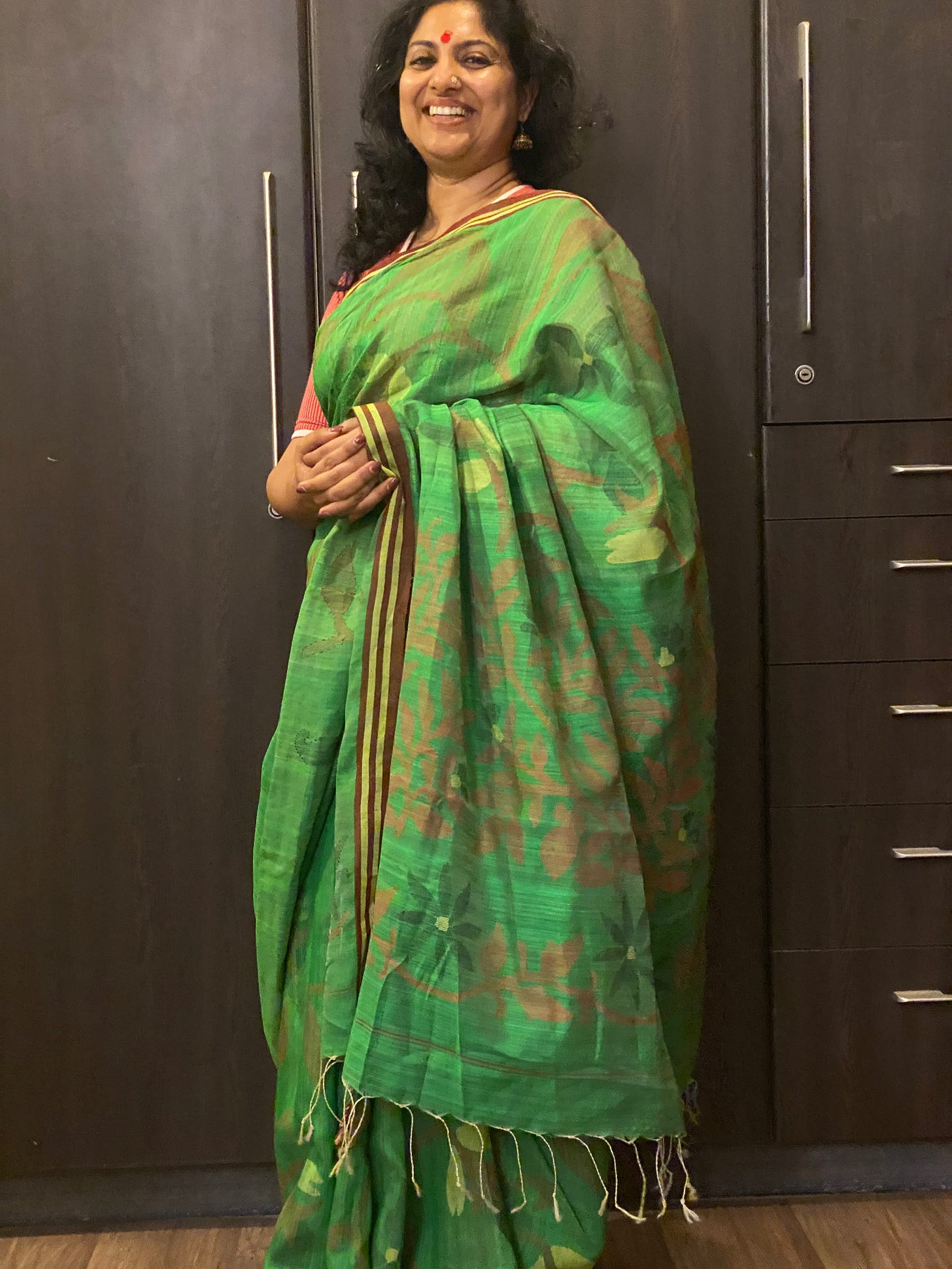
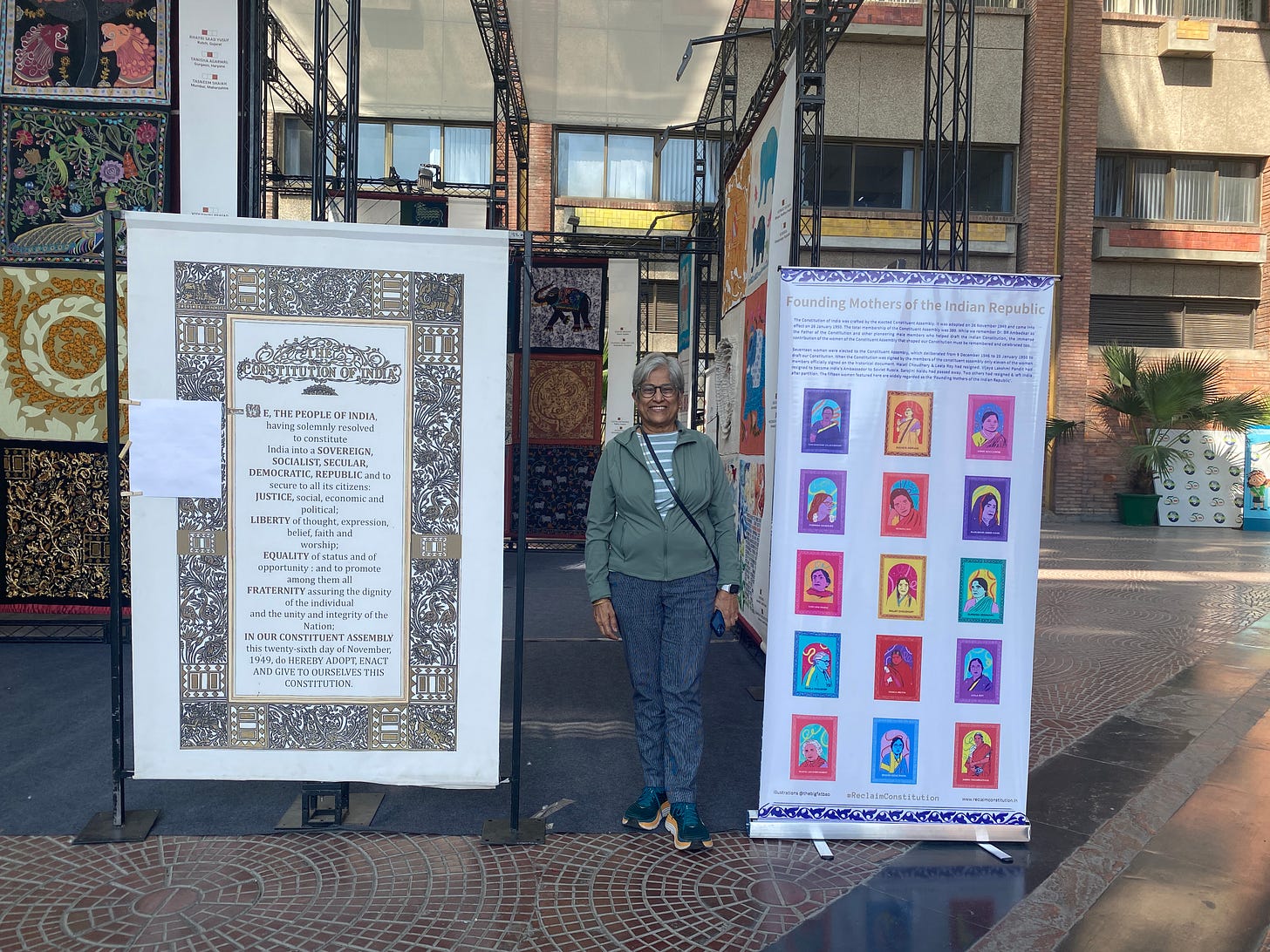
In my early years in Delhi, circa 1950s, the door to door sales world was vibrant! Even in the sarkari colony where we lived, vegetable and fruit vendors were daily visitors. But other wares like cooking and stainless steel bartans (still a novelty at the time), sarees, rolls of pant and shirt material (the pre-ready made days), bangles, toys etc were regularly on offer. Also, many services were offered. One could sharpen knives, aluminium coat 'peetal' cooking vessels, repair umbrellas.....etc. And then as winter arrived, the Afghani men with the dry fruits would arrive.....the taste of those chilgosas still linger in my mouth!
Thank you for bringing back to memory this world of mobile traders. They would fill our homes with the delights of shawls from Kashmir, kantha from Shantiniketan and chikankari from Lucknow. Loved the craft and storytelling style.